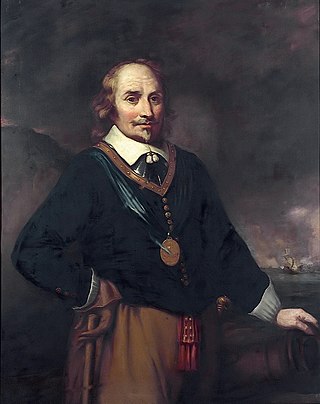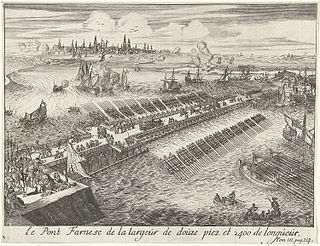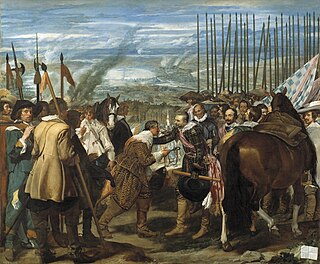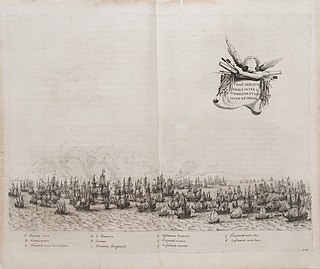
Maarten Harpertszoon Tromp or Maarten van Tromp was an army general and admiral in the Dutch navy during much of the Eighty Years' War and throughout the First Anglo-Dutch War. Son of a ship's captain, Tromp spent much of his childhood at sea, during which time he was captured by pirates and enslaved by Barbary corsairs. In adult life, he became a renowned ship captain and naval commander, successfully leading Dutch forces fighting for independence in the Eighty Years' War, and then against England in the First Anglo-Dutch War, proving an innovative tactician and enabling the newly independent Dutch nation to become a major sea power. He was killed in battle by a sharpshooter from an English ship. Several ships of the Royal Netherlands Navy have carried the name HNLMS Tromp after him and/or his son Cornelis, also a Dutch admiral of some renown.

The Anglo–Dutch Wars were a series of conflicts mainly fought between the Dutch Republic and England in the mid-17th and late 18th century. The first three wars occurred in the second half of the 17th century over trade and overseas colonies, while the fourth was fought a century later. Almost all the battles were naval engagements.

The Eighty Years' War or Dutch Revolt was an armed conflict in the Habsburg Netherlands between disparate groups of rebels and the Spanish government. The causes of the war included the Reformation, centralisation, excessive taxation, and the rights and privileges of the Dutch nobility and cities.

The naval Battle of Gibraltar took place on 25 April 1607, during the Eighty Years' War, when a Dutch fleet surprised and engaged a Spanish fleet anchored at the Bay of Gibraltar. During the four hours of action, most of the Spanish ships were destroyed.

The fall of Antwerp on 17 August 1585 took place during the Eighty Years' War, after a siege lasting over a year from July 1584 until August 1585. The city of Antwerp was the focal point of the Protestant-dominated Dutch Revolt, but was forced to surrender to the Spanish forces under the command of Alessandro Farnese. Under the terms agreed, all the Protestants of Antwerp were given four years to settle their affairs and leave the city. Many migrated north, especially to Amsterdam. Apart from losing a high proportion of its middle class and mercantile population, Antwerp's trade suffered for two centuries afterwards as Dutch forts blockaded the River Scheldt until 1795.
The naval Battle of Puerto de Cavite took place on 10 June 1647 during the Eighty Years' War between a Spanish fleet and a Dutch fleet in Puerto de Cavite, an important Spanish port in Manila Bay, Philippines in which the Dutch were defeated.

The Battle of Oosterweel took place on 13 March 1567 near the village of Oosterweel, near Antwerp, in present-day Belgium, and is traditionally seen as the beginning of the Eighty Years' War. A Spanish mercenary army surprised a band of rebels and killed or captured almost all of them.
The Battle of Flushing was a naval battle of the Eighty Years' War, fought on April 17, 1573 near the city of Flushing, Netherlands. The Spanish fleet was led by Sancho d'Avila, the Dutch fleet by Lieven Keersmaker.

The Battle on the Zuiderzee was a naval battle during the Eighty Years' War in which a Dutch fleet destroyed a larger and better-equipped Spanish fleet on the Zuiderzee.

The Battle of the Scheldt also known as the Battle of Walcheren was a naval battle that took place on 29 January 1574 during the Eighty Years' War and the Anglo–Spanish War. The battle was fought between a Dutch rebel Sea Beggar fleet under Lodewijk van Boisot and a Spanish fleet under Julián Romero. The Spanish fleet was attempting to relieve the Spanish held town of Middelburg which was under siege but the fleet under Boisot intercepted them and were victorious with the destruction or capture of nearly fifteen ships. Middelburg as a result then surrendered only nine days later along with Arnemuiden.

La rendición de Breda is a painting by the Spanish Golden Age painter Diego Velázquez. It was completed during the years 1634–35, inspired by Velázquez's visit to Italy with Ambrogio Spinola, the Genoese-born Spanish general who conquered Breda on June 5, 1625. The painting depicts the exchange of the key of Breda from the Dutch to the Spanish.
Ivan Dirkie de Veenboer was a 17th-century Dutch corsair. A privateer during the Eighty Years' War, he later turned to piracy and became an officer under Simon the Dancer. He later converted to Islam, becoming known as Süleyman Reis, and had a highly successful career as an Ottoman captain and Barbary corsair commanding the Algiers corsair fleet during his later years.

The Battle of Gibraltar took place on 10 August 1621, during the Eighty Years' War between the Spanish Empire and the Dutch Republic. A Dutch East India Company fleet, escorted by a squadron under Willem Haultain de Zoete, was intercepted and defeated by nine ships of Spain's Atlantic fleet under Fadrique de Toledo while passing the Strait of Gibraltar.

The Battle off Lizard Point was a naval action which took place on 18 February 1637 off the coast of Cornwall, England, during the Eighty Years' War. Spanish admiral Miguel de Horna, commander of the Armada of Flanders, intercepted an important Anglo-Dutch merchant convoy of 44 vessels escorted by six Dutch States Navy warships, sinking or capturing 20 ships before returning safely to his base in Dunkirk.
Battle of Cape St. Vincent may refer to:

The action of 12–17 January 1640 was a naval battle between a Dutch fleet and a combined Spanish-Portuguese fleet during the Eighty Years' War. The battle took place on the Brazilian coast off Pernambuco and was an attempt by a fleet consisting of approximately eighty vessels transporting about 5,000 soldiers under the command of Portuguese Admiral Fernando de Mascarenhas to land reinforcements to bolster the Portuguese militia besieging the city of Recife. On 12 January this fleet was intercepted by a Dutch task force of about forty ships commanded by Willem Loos. The ensuing battle lasted with occasional breaks until the evening of 17 January, when the Spanish and Portuguese fleet retreated and sailed away to the north.

The siege of Calais of 1596, also known as the Spanish conquest of Calais, took place at the strategic port-city of Calais, between 8 and 24 April 1596, as part of the Franco-Spanish War (1595–1598), in the context of the French Wars of Religion, the Anglo-Spanish War (1585–1604), and the Eighty Years' War. The siege ended when the city fell into Spanish hands after a short and intense siege by the Spanish Army of Flanders commanded by Archduke Albert of Austria, Governor-General of the Spanish Netherlands. The French troops in the citadel of Calais resisted for a few days more but finally, on 24 April, the Spanish troops led by Don Luis de Velasco y Velasco, Count of Salazar, assaulted and captured the fortress, achieving a complete victory. The Spanish success was the first action of the campaign of Archduke Albert of 1596.

The Battle of the Gulf of Almería, also known as the Battle of Almería Bay or the Battle of Cape of Palos, was a naval Spanish victory that took place in late August, 1591, off Almería, near the Cape Palos, during the Eighty Years' War and the Anglo–Spanish War (1585–1604). The battle occurred when the Spanish fleet of the Adelantado of Castile, Don Martín de Padilla y Manrique, Count of Santa Gadea, sighted an Anglo-Dutch fleet in the waters of Almería, on the southern coast of Spain. The Spanish fleet, led by Martín de Padilla, attacked with such fury the Anglo-Dutch fleet who managed to undo their training, achieved a great success. About 20 Dutch ships and 3 English ships were captured by the Spaniards, and some ships of the rest of the Anglo-Dutch fleet were seriously damaged. On the other hand, the Spanish losses were minimal.

The Battle of Cape St. Vincent was a naval engagement that took place on 16 June or 6 October 1606, during Eighty Years' War and Dutch–Portuguese War. A Spanish fleet under Admiral Luis Fajardo attacked the Dutch fleet led by Admiral Willem Haultain and Vice Admiral Regnier Klaazoon, which was blocking the Spanish-Portuguese coast to intercept the Spanish treasure fleet. The battle concluded in a Spanish victory; in which Klaazoon's flagship was destroyed, two ships were captured, and Haultain fled with the rest of the fleet to his country without having achieved his purpose.

The years 1599–1609 constituted a phase of in the Eighty Years' War between the Spanish Empire and the emerging Dutch Republic. It followed the Ten Years (1588–1598) that saw significant conquests by the Dutch States Army under the leadership of stadtholders Maurice of Nassau and William Louis of Nassau-Dillenburg, and ended with the conclusion of the Twelve Years' Truce (1609–1621) on 9 April 1609. The 1599–1609 period was generally marked by a stalemate; the well-known Battle of Nieuwpoort (1600) brought the Dutch a tactical victory without long-term gain, while Spanish conquests in the Siege of Ostend (1601–1604) and Spinola's 1605–1606 campaign were effectively balanced out by the Dutch naval triumph in the Battle of Gibraltar (1607) and the Spanish state bankruptcy that same year. Financial troubles were amongst the primary motives that prompted the Dutch, and even more so the Spanish, to head to the negotiating table for a ceasefire.















